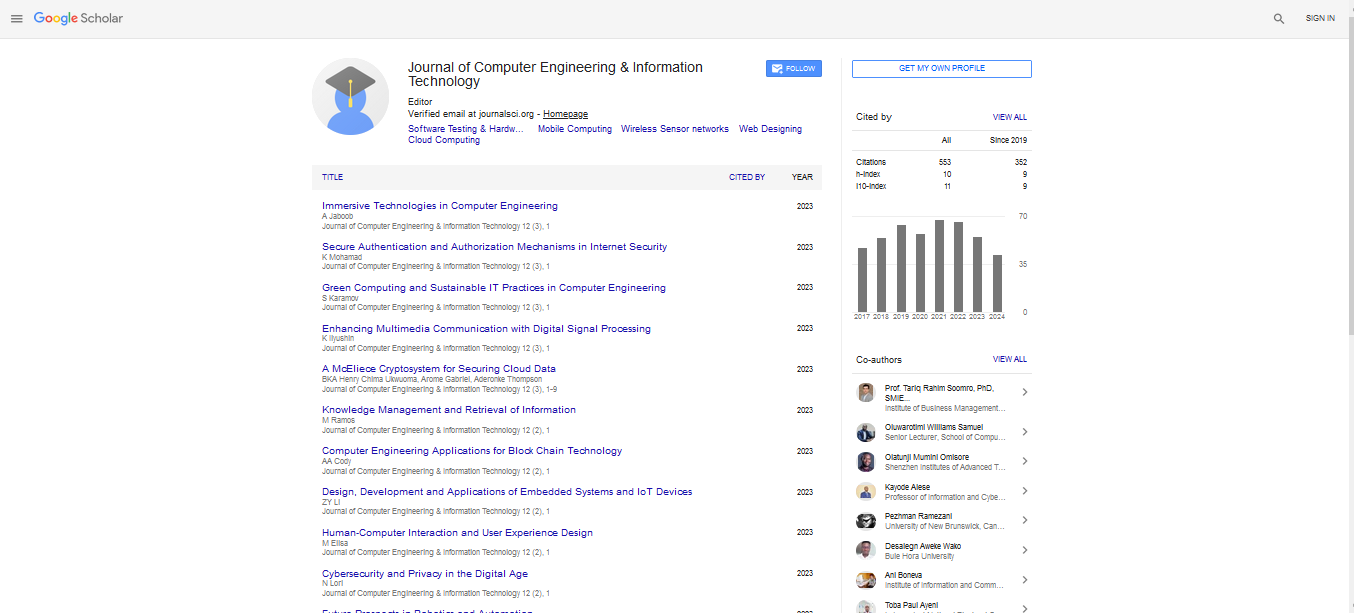Commentary, J Comput Eng Inf Technol Vol: 13 Issue: 5
Ensuring Compliance and Governance in Cloud Environments
Soner Tam*
1Department of Machine Learning, Van Yuzuncu Yıl University, Van, Turkey
*Corresponding Author: Soner Tam,
Department of Machine Learning, Van
Yuzuncu Yıl University, Van, Turkey
E-mail: soner.tam23@gmail.com
Received date: 13 August, 2024, Manuscript No. JCEIT-24-146810;
Editor assigned date: 16 August, 2024, Pre QC No. JCEIT-24-146810 (PQ);
Reviewed date: 30 August, 2024, QC No. JCEIT-24-146810;
Revised date: 06 September, 2024, Manuscript No. JCEIT-24-146810 (R);
Published date: 13 September, 2024, DOI: 10.4172/2324-9307.1000313
Citation: Tam S (2024) Ensuring Compliance and Governance in Cloud Environments. J Comput Eng Inf Technol 13:5.
Description
As organizations increasingly migrate to cloud environments, ensuring compliance and governance becomes grave to managing risk, protecting sensitive data and adhering to regulatory requirements. Cloud computing introduces unique challenges for compliance and governance due to its dynamic, distributed nature. This discuss the key aspects of ensuring compliance and governance in cloud environments, including the challenges, strategies and best practices for maintaining control and meeting regulatory obligations. In cloud environments, organizations often have limited visibility into the underlying infrastructure and security controls provided by the cloud provider. This lack of visibility can hinder compliance efforts and make it challenging to monitor and manage data access and usage. Regulatory requirements often include specific reporting obligations, such as breach notifications or compliance certifications. Organizations must establish processes for generating and submitting required reports and ensure that they meet the standards set by regulatory bodies.
Develop and implement policies and procedures that address compliance requirements and governance practices. These policies should cover areas such as data protection, access controls, incident response, and vendor management. Ensure that policies are communicated to all stakeholders and regularly reviewed and updated. Clearly define roles and responsibilities for compliance and governance within the organization. Assign responsibilities for managing data protection, monitoring compliance and responding to regulatory changes. Ensure that individuals responsible for compliance have the necessary training and resources. Assess cloud providers' certifications and compliance with industry standards and regulations. Providers with certifications such as ISO 27001, SOC 2, or PCI-DSS demonstrate adherence to security and compliance best practices. Verify that the provider’s certifications align with your organization’s regulatory requirements.
Review Service Level Agreements (SLAs) to ensure that the cloud provider commits to compliance with relevant regulations and provides adequate security controls. SLAs should include provisions for data protection, incident response and audit rights. Ensure that the provider’s responsibilities align with your organization’s compliance requirements. Ensure that data is encrypted both at rest and in transit. Use strong encryption algorithms and manage encryption keys securely. Implement encryption for sensitive data to protect against unauthorized access and meet regulatory requirements. Implement robust access controls to manage who can access and modify data. Use Role-Based Access Control (RBAC) to restrict access based on user roles and responsibilities. Regularly review and update access permissions to ensure that they align with the principle of least privilege. Deploy monitoring tools to continuously track cloud activities and detect potential compliance issues. Monitoring tools should provide visibility into resource usage, data access and security events. Use these tools to identify and address issues proactively.
Conduct regular internal and external audits to assess compliance with regulatory requirements and governance policies. Audits should review security controls, data protection practices and adherence to policies and procedures. Address any findings or deficiencies identified during audits. Stay informed about changes in regulations and industry standards that impact cloud compliance. Subscribe to regulatory updates, participate in industry forums and consult with legal and compliance experts to stay current with evolving requirements. Adapt policies and practices in response to regulatory changes and emerging threats. Regularly review and update compliance frameworks, data protection measures and governance practices to ensure ongoing adherence and effectiveness.
Use a risk-based approach to prioritize compliance and governance efforts based on the potential impact and likelihood of risks. Assess the risks associated with data, applications, and cloud services and implement controls and practices that address the most significant risks. Utilize cloud-native tools and services provided by cloud providers for compliance and governance. These tools may include security monitoring, data encryption, identity management and compliance reporting features. Influencing these tools can simplify compliance efforts and enhance governance. Collaborate with cloud providers to understand their compliance practices and security controls.
Ensuring compliance and governance in cloud environments is essential for managing risk, protecting data, and meeting regulatory obligations. By addressing key challenges, implementing effective strategies, and following best practices, organizations can maintain control over their cloud resources and ensure adherence to legal and regulatory requirements. A comprehensive approach to compliance and governance involves developing robust policies, selecting compliant cloud providers, implementing data protection measures, monitoring and auditing cloud environments, and staying informed about regulatory changes. As cloud computing continues to evolve, maintaining a strong focus on compliance and governance will be vital for achieving security, efficiency and regulatory adherence in the cloud.
 Spanish
Spanish  Chinese
Chinese  Russian
Russian  German
German  French
French  Japanese
Japanese  Portuguese
Portuguese  Hindi
Hindi 